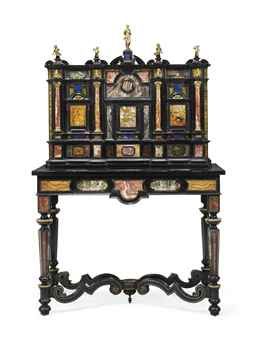Replacing the carved buffet popular in the previous century, the cabinet - or cabinet on stand - became a real object of desire in households who were wealthy. Cabinets were primarily intended for display purposes, a response to the new passion for collecting among the wealthy, and the need to house all the rare and wonderful objects that they had acquired.
Rather than just a repository for special collections, however, the cabinet itself became a show piece, as skilled craftsmen created large and much more grand scale versions that were works of art in their own right, using precious materials, rare panels of pietra dura, lacquer panels from the Orient, and veneers of ebony and ivory were all incorporated into architecturally inspired cabinets. This was the ultimate expression of wealth!

Decorative Elements
The wealthiest patrons commissioned handmade furniture, pietra dura tabletops or panels for their cabinets. It was also fashionable to insert exotic and patterned lacquer panels from Japanese or Chinese cabinets into European furniture, now reproduction furniture.
This was, however, prohibitively expensive, so innovative craftsmen developed their own methods of imitating lacquerwork, such as Japanning.
As well as actual lacquered objects, a fashion developed for Oriental scenes - known as Chinoiserie.
Cabinet makers became very skilled at veneering, using exotic hardwoods and inlays. The Low Countries, in particular, produced exquisite floral marquetry.
French boullework created a sumptuous decorative veneer for tables and cabinets using detailed brass and tortoiseshell marquetry.

By the end of the century, French fitted furniture design was highly influential. Louis XIV's palace at Versailles set the style for the fashionable world. Changes in furniture style were keenly watched and interpreted by craftsmen in Britain and the rest of Europe. The finest French pieces - such as tapestries from the Gobelins workshops or cabinets by Boulle - were highly sought after in the grand homes of the very wealthy.
No comments:
Post a Comment